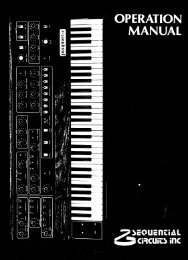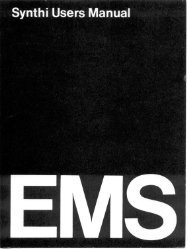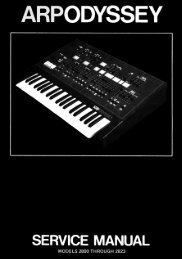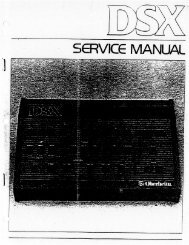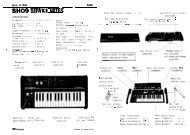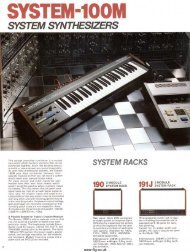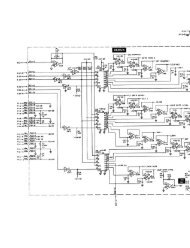ARP2600 - Fundamentals of Music Technology - Cyborgstudio.com
ARP2600 - Fundamentals of Music Technology - Cyborgstudio.com
ARP2600 - Fundamentals of Music Technology - Cyborgstudio.com
Create successful ePaper yourself
Turn your PDF publications into a flip-book with our unique Google optimized e-Paper software.
SECTION SIX: VCF - 043This analogy is a good one because as the water passes through the handkerchief, some <strong>of</strong> it is absorbedby the handkerchief, so not all <strong>of</strong> the water is allowed to pass through. This holds true when passingsounds through a filter. While the unwanted harmonics can be removed, some <strong>of</strong> the other harmonicsend up being filtered out as well.When learning about filters, it is important to understand that there are many types <strong>of</strong> filters. Earlysynthesizers usually only <strong>of</strong>fered the user one type <strong>of</strong> filter, but sometimes had as many as four. Modernsynthesizers, however, may <strong>of</strong>fer as many as 36 different types <strong>of</strong> filters! The study <strong>of</strong> some <strong>of</strong>these more esoteric filters is, for the moment, beyond the scope <strong>of</strong> this first volume, but they will betaken up at a future time. It is also worth noting at this time that most older synthesizers had only onefilter on them, but modern synthesizers sometimes have as many as 128 independent filters!WHAT DO FILTERS DO?The exact electronic workings <strong>of</strong> a filter are unimportant at this time. It is very important, however, tounderstand the function <strong>of</strong> a filter. As stated above, a filter removes unwanted harmonics, along with afew <strong>of</strong> the wanted harmonics. However, one cannot pick and choose exactly which harmonics onewants to remove. To take the next step in understanding, one must first understand that there are fourbasic types <strong>of</strong> filters, each <strong>of</strong> which performs a specific job.The four basic types <strong>of</strong> filters found on older synthesizers are lowpass, bandpass, band reject andhighpass. Of the four, the lowpass filter is by far the most <strong>com</strong>mon. The ARP 2600 has one lowpassfilter, but has no other filters. (The noise generator has a lowpass filter on it, but it is dedicated to thenoise generator’s output, and cannot be used for general purpose filtering.) Each type <strong>of</strong> filter is capable<strong>of</strong> filtering different ranges <strong>of</strong> harmonics. Some filters have the circuitry for some or all <strong>of</strong> thesedifferent types <strong>of</strong> filters. When a filter can operate in more than one mode (for example highpass andlowpass) it is said to be a multimode filter. Some synthesizers have filters that can actually perform all<strong>of</strong> these types <strong>of</strong> filtering simultaneously!LOWPASS FILTERSLowpass filters filter out high harmonics. At first, ‘lowpass’ may seem like a strange name for a filterthat attenuates high harmonics, but it does make some sense. Filters are named by the information theyallow to pass through rather than by the information they remove. So, a lowpass filter will allow allinformation below a certain frequency to pass through, while a highpass filter will allow all informationabove a certain frequency to pass through.Although filters have several parameters, the most important is the cut<strong>of</strong>f frequency. Cut<strong>of</strong>f frequencyis abbreviated Fc. Cut<strong>of</strong>f frequency is the frequency at which the filter will begin to attenuate thevolume <strong>of</strong> harmonics. This attenuation is actually how a filter filters out harmonics. On the ARP 2600,Fc is set using two controls. There is an INITIAL FILTER FREQUENCY slider, and a FINE TUNEslider, which function much like the corresponding sliders on the VCO’s. Instead <strong>of</strong> determining thefrequency <strong>of</strong> an oscillator, however, here they determine the Fc. This is yet another example <strong>of</strong> amaster-submaster relationship. These controls can be seen in Figure 6-2 on page 44.




